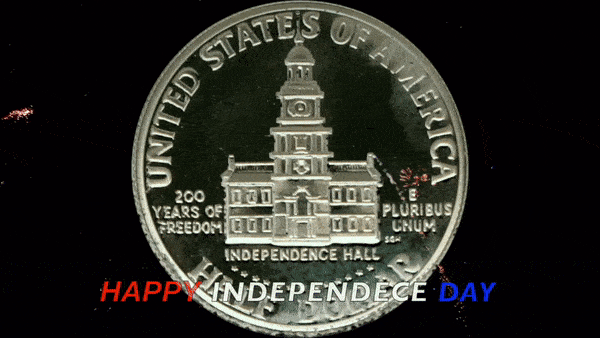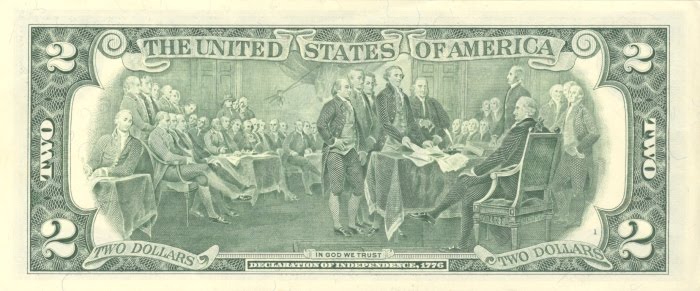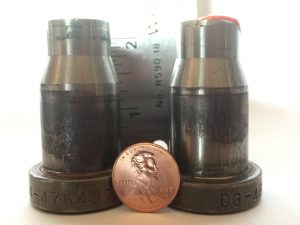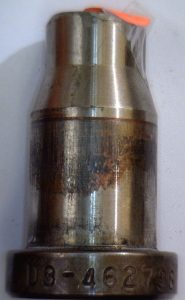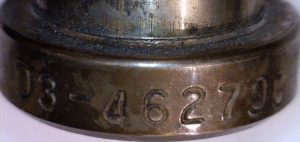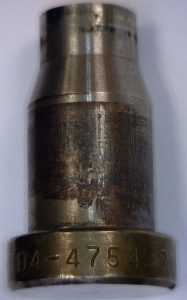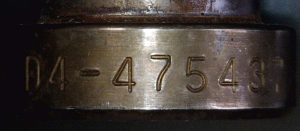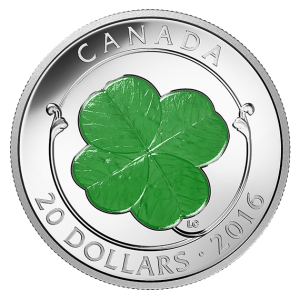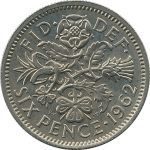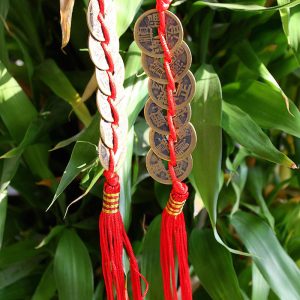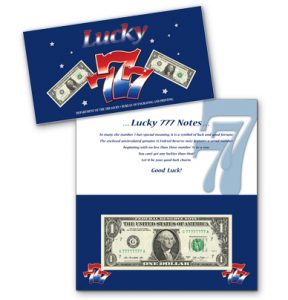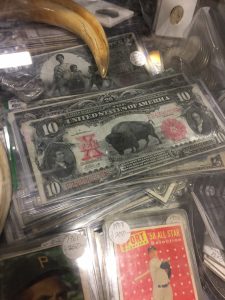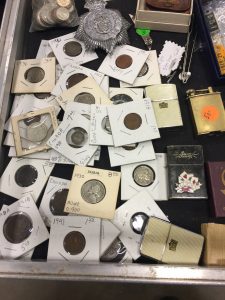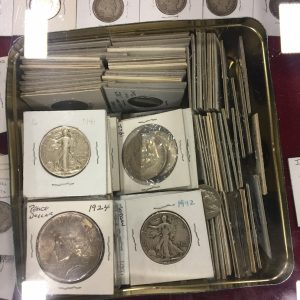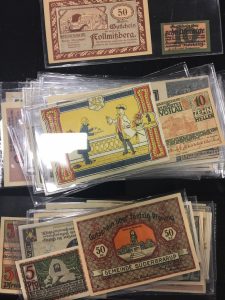Finding error dies
Dies from the U.S. Mint makes for an interesting collectible. Standing about 2½ inches tall and about 1¼ inches across the base where it is loaded into the coining press, it is really an unremarkable piece of metal. Weighing 192 grams (about 6.8 ounces), the only distinguishing marks on the die is the serial number stamped on the base.
Before being discarded, workers at the U.S. Mint are supposed to completely grind off the design so that it cannot be used to strike counterfeit coins. Even though it is not cost effective to flood the U.S. economy with counterfeit Lincoln cents, the U.S. Mint does not want to take the chance someone will try. Once the design is removed from the die it can become a collectible.
Close-up images of the dies make the visible design look more dramatic than in person. After all, the images were likely taken with a macro lens on a die used to strike a coin 19.05 mm (0.750 inches) in diameter. Even so, the idea was fascinating enough for me to submit bids high enough to win both dies.
The first “error” die was used to strike the obverse of 1993-D Lincoln cents. This die is not completely filed down since it does show some of Lincoln’s hair. Although not a large area, there is enough of the incuse portion of the die’s section to be able to identify it as hair and providing a good guess as to where it would be on the coin. The sticker in the image was placed there by the seller. I decided to leave the sticker.
- View of the 1993-D Lincoln Cent obverse die
- Serial number for the 1993-D Lincoln Cent obverse die shows the D for Denver, 3 for 1993, and followed by a sequence number
- Close up of the 1993-D Lincoln cent die showing part of the hair design still visible.
The other error die was used to strike the reverse of 1994-D Lincoln cents. In this case, the “error” is very subtle. There are two lines that would have been where the bottom two steps of the Lincoln Memorial would have been. Based on the placement, these would be to the center-right of the Lincoln statue in the monument. In the image, it is at the bottom of the “R.” I do not know why the “CR” is written on the die but I am not removing it, for now.
- View of the 1994-D Lincoln Cent reverse die
- Serial number for the 1994-D Lincoln Cent reverse die shows the D for Denver, 4 for 1994, and followed by a sequence number
- Close up of the 1994-D Lincoln cent reverse die showing a small section of the steps to the Lincoln Memorial still visible
I do not know how Fred Weinberg finds these items but they are fascinating. The next time you go to a show you should check out his inventory. He finds some really interesting errors that have to be seen to be believed.
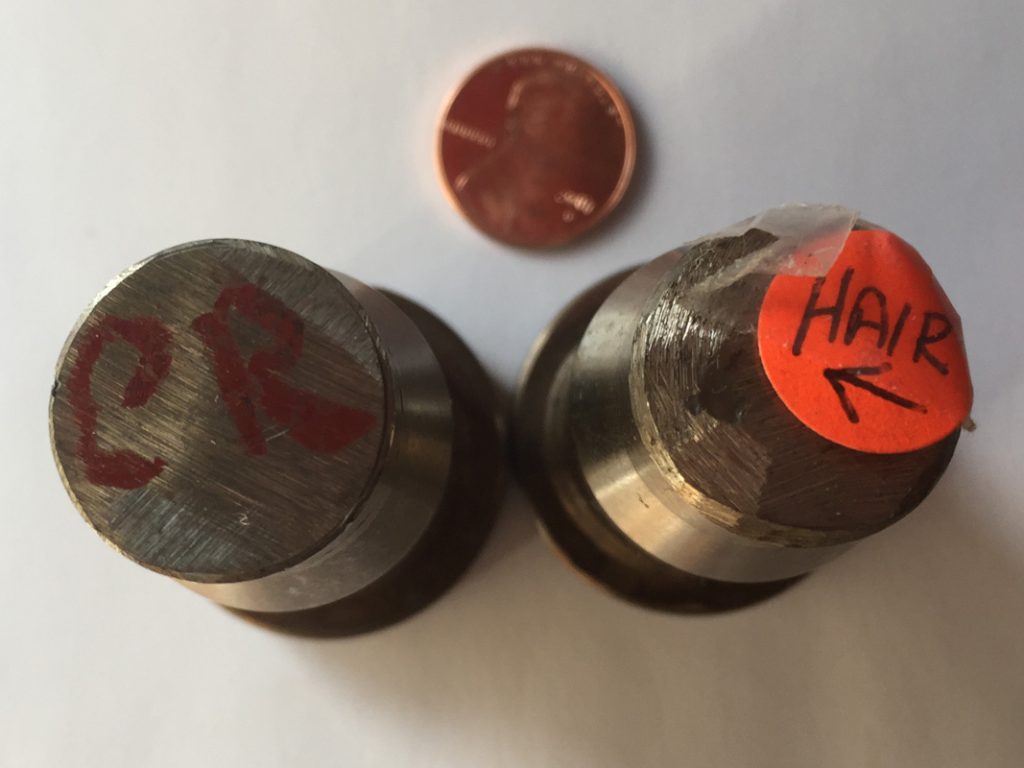
Looking down on the Lincoln Cent “error” dies. The 1994-D reverse die is on the left, The 1993-D obverse die is on the right.
It’s lucky
Patrick was not welcomed when he arrived but worked with the society to convert them to Christianity. Although most of his writings portrayed that he was probably more successful than he was, but after working with the people, first in the northern regions of Ireland, he did find success. He once wrote that he baptized thousands of people and some have written that he baptized hundreds on a single day. Using the native three-leaf shamrock to describe the Holy Trinity, Patrick was promoted bishop and apostle of Ireland. He died on March 17, 461 in Saul, where he founded his first church.
For thousands of years, the Irish have observed the day of Saint Patrick’s death as a religious holiday, attending church in the morning and celebrating with food and drink in the afternoon. The first St. Patrick’s Day parade was celebrated in 1762 when Irish soldiers serving in the English military marched through New York City.
With Saint Patrick’s Day, talk about “the luck of the Irish” and associate the shamrock of four-leaf clover as a lucky symbol. I was thinking if there are coins or currency that would bring you luck. After searching around online for lucky coins there was a common theme: something that is special to you. Here is a composite of the types of lucky coins:
- Coins from the year of your birth: I have helped several people buy proof and mint sets of coins from the year they were born. On one of my father’s milestone birthdays, I bought uncirculated coins from the year of his birth and had them slabbed in an NGC multi-coin holder when they were still being offered.
- Coins from a country special to you: On one of my wife’s milestone birthdays, I purchased a Canadian proof set from the year of her birth. Although she was born in the United States, her parents were from Canada and it has become a special collectible.
- Coins that have a special meaning: A friend keeps a Morgan Dollar in his top desk drawer. The desk used to belong to his grandfather who kept that coin as his “emergency dollar” during the Great Depression.
- Coins found during a happy or coincidental time: A client once showed me a 1958 Cuban peso that he found on the street in Miami that he keeps as a pocket piece. He decided that since it was the same year his family fled Cuba, it was a fortuitous find.
- Coins of a specific design: Sometimes the design may be added to the coin. I once met someone who had several Love Tokens from his relatives he says it is his family’s way of watching over him.
A silver sixpence in her shoe
A more specific coin that is supposed to bring luck is the British sixpence. According to the Victorian poem, to bring luck to the marriage, the bride is supposed to wear “Something old, something new, something borrowed, something blue, and a silver sixpence in her shoe.” The lucky sixpence would be placed in her left shoe by her father to wish his daughter good health and great wealth for the couple. Although the sixpence was discontinued in 1971 when the United Kingdom converted from the old system to decimalization. The tradition remains popular in the UK and to a certain degree in the U.S. except a silver quarter is used.Feng Shui
Then there are Feng Shui Coins. These are Chinese lucky coins that are supposed to attract wealth and success. Feng Shui coins are round and have a square hole in the middle. The round shape represents the heavens. The square is a symbol of the four corners of the earth. For luck, Feng Shui coins should be tied together using a red ribbon or thread. The red ribbon is said to activate the power of the coins to protect your existing income and attracting more money.The number of coins tied together is important. One coin is believed to promote loneliness and will leave you empty. Two is better but does not have the power of rebirth that three does. Three coins tied together represents the heavens, earth, and mankind. Four represents death and not something that would promote Feng Shui. The Chinese do not know why five is not lucky but this is accepted. While three is considered proper Feng Shui, making it more powerful would be three-times-three, or nine, coins.
For luck, you can hang Feng Shui coins on the on the inside of your front door, not the outside. You want the luck inside. Do not hang your Feng Shui coins on your back door because it will luck to leave your house.
You can place three Feng Shui coins on top of items to bring them luck. When you do this, it is important to place the Yang side facing up to invite the luck to protect your item. The Yang side is the side with the four characters.
When giving a gift, attach three Feng Shui coins to the package to bring double happiness. It tells the recipient that with the gift you are also wishing them wealth, prosperity, and happiness. Doing this will add to your Feng Shui for giving generous and unselfish wishes.
Numerology and currency
Numerology is the belief in the divine or mystical relationship between numbers and the physical world. Many people practice a mild form of numerology called a “lucky number.” For those who believe in some type of numerology can turn to the serial number of currency to add to their collection.
One of the more expensive aspects of notaphily is the collection of patterns numbers. Typical patterns are as follows:
- Solid: every digit the same
- Ladder: numbers that count up, like 12345678, or down, like 98765432
- Low or High numbers
- Radar numbers: when the serial number repeats forward and backward, like 12344321
- Repeater numbers: when the serial number is repeated, like 12341234
- Super Repeater: pairs of numbers that repeat four times, like 36363636
- Double Quad: two pairs of four numbers, like 88889999
- Seven of a kind: both in a row or seven of the same number
Notes that represent dates can bring luck such as one that has your birthdate. For someone born on March 17, 1977, finding a note with the serial number 03171977 or even 19770317 could be very lucky. Since the numbers reset for every series and there are 12 Federal Reserve branches used as a prefix, you have quite a few chances of finding these.
Of course, the Bureau of Engraving and Printing will help. If you go to their website at moneyfactorystore.gov and look under Premium Products, they sell special sets with serial numbers from the current year.The BEP also sells lucky money that includes the Lucky 7 set. These notes have a serial number that begins with three 7s. You can also buy notes in special Chinese holders with serial numbers that begin with “8888” and “168.” In Chinese, the “eight” sounds similar to the word for “prosper” or “wealth.” Selling the Lucky 8888 note is to help promote prosperity and wealth.
The “168 Prosperity Forever” note plays on the Mandarin pronunciation of the number that sounds similar to “prosperity forever.” If the BEP used the Cantonese pronunciation, they would have the use the serial numbers beginning “768.”
Go find your lucky coin and may you have health and prosperity.
- Canadian coin image courtesy of the Royal Canadian Mint
- Sixpence image courtesy of Wikipedia
- Feng Shui coins image courtesy of eBay user “technology-onsale“
- Lucky 777 Note courtesy of the Bureau of Engraving and Printing
POLL: Will you buy the 2018 Red Book?
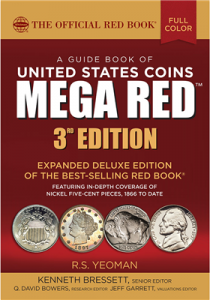 Whitman Publishing just announced that the Red Book and MEGA RED Book will be available at the Whitman Baltimore Expo the weekend of March 30-April 2.
Whitman Publishing just announced that the Red Book and MEGA RED Book will be available at the Whitman Baltimore Expo the weekend of March 30-April 2.
Over the last few years, Whitman has been adding more information to the Red Book to entice people to buy a new edition each year. This year, they are adding new information to the MEGA RED Book to the book whose page count continues at 1,504 pages. It is physically a large book with a lot of information.
The key feature of the Red Books are the prices. Prices are set by industry insiders who report what they have seen as prices for coins. Because of the publishing lead times, the prices may not be accurate to market conditions. Some say that the prices are not in line with current prices because the market moves quickly. In fact, a comparison with online resources like the Numismedia Fair Market Value prices and PCGS Price Guide shows that the Red Book may need updating for the most common coins. The disparity is that great.
Even so, the Red Book in all its forms probably is the bestselling book on U.S. coins of all time. Whenever someone wants to know more about U.S. coins and what they are worth, the persistent recommendation is to tell them to buy a copy of the Red Book.
This brings us to the latest poll question:
Will you buy a 2018 Red Book?
Total Voters: 19
Select as many as you want. If you have another opinion, add your comments to this post.
Oops… I’m sorry! I messed up!
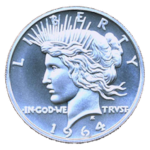 Some of you might have noticed that many of the links to the blog stopped working properly. I know that the indexing robots (e.g., Google, MSN, Yahoo) have been filling my error log with messages.
Some of you might have noticed that many of the links to the blog stopped working properly. I know that the indexing robots (e.g., Google, MSN, Yahoo) have been filling my error log with messages.
Over the weekend I made some behind the scenes adjustments so that I can add new features. Apparently, most of my work went without a problem except I selected the wrong options. I think it is fixed now.
Don’t worry about telling me that something went wrong, I will be watching the logs to make sure everything is correct. The logs will give me more information about what is happening behind the scenes to identify the problems.
This is my fault and I apologize for the issues.
Buying your collectibles someplace other than coin shows
Estate Sales and Auctions
In my current business, I am able to buy inventory from estate sales and estate auctions. Most estate sales are either the lifetime accumulation of a deceased loved one or a forced sell-off of assets mainly as part of a court-ordered restructuring. An estate sale company will come into a home, stage it for a sale, add prices to everything and open the house for the public to buy what they want.
Adding prices mean tagging the items with a price that the company running the estate sale thinks is a fair price for the item. This tagging also has these sales also called Tag Sales. When it comes to tagging, some companies are better than others. After they pick the better items, the rest of the house is tagged either at prices too low or prices too high because most of the estate sales company do not know about the items they sell. They might use an average price of similar items they sold in the past or they just pull prices out of the air.
Estate sale companies have little to know expertise with coins and currency which is reflected in their prices. I cannot tell you how many times that I have walked into an estate sale and seen common date Morgan and Peace dollars priced at over market value.
Unfortunately, many of these companies are not interested in learning about how to price coins. During a recent estate sale, I found quite a number of Walking Liberty half dollars. Most were in the VG-XF range. Some were better dates but none were the 1921 key date coins. Using the Numismedia Fair Market Value pricing guide I came up with a bulk price that I feel was fair for the entire lot. Unfortunately for the company, it was less than 50-percent below their price and about 20-percent lower than the fair market value. I am a reseller and I need to be able to make a profit. The manager on site acted as if I told him his baby was ugly.When I presented my offer, I told him that I understood the coin market and would explain how I came up with the price. I showed him the Numismedia Fair Market Value pricing guide and explaining that it is a retail price guide. Confused by the differences in grade pricing he questioned how to grade coins, I show him the condition of the coins compared to the images in the PCGS Photograde app. After being confused by everything he said that he would take a chance on his price and turned down my offer.
I returned to the estate sale on Sunday afternoon about a half-hour before closing and noticed that none of the coins sold. I lowered my offer to a small percentage above its melt value. The offer was declined. A week later I found out that the coins were brought to a local coin shop. Imagine their surprise when they were offered a price between my two prices.
If you go estate sale shopping for coins, be prepared to be patient. Even though it is not their merchandise, they act as if it is their personal property. Most will be reasonable if you are reasonable with them. I would recommend reviewing the “Negotiating” section in my post “How Are Coins Priced (Part II).”
Estate auctions are very different than what most people are used to if their only experience has either been at coin shows or eBay. If you attend a live estate auction, there is a possibility to purchase bargains. But like any auction, two people can also drive the price of the coin higher than fair market value. Most auctioneers understand how coins are priced and how bullion-based coins should not sell below their current melt value.In my experience, gold and U.S. Mint packaged items usually sell at prices greater than fair market value. I cannot tell you why a 1977 Proof Set would sell for $15 when it is valued at $8, but it happens at these auctions.
If you are not involved in this market, there is a world of online estate auctions that hides in the open. Online estate auctions are hosted on sites that are not quite well known outside of those of us who work and shop in this world. These auctions are simply a company imaging and posting the inventory online, managing the auction, collecting money, and making sure everyone is paid. Most companies will hold absolute auctions that run for 7-10 days with all items starting at $1.00.
For those who do not know, an absolute auction is one where the lots sell at whatever the price is when bidding ends, also known as the hammer price in reference to a hammer that is used during live auctions. Winners will also pay a buyer’s fee which average 15-percent of the hammer price.
Although it is possible to find bargains in these estate auctions, many times I have seen numismatic items sell for more than fair market value. This is not good if you are a re-seller but sellers are doing well.
Antique Shows and Flea Markets
I go to a lot of antique shows and flea markets. I will set up a table at a few flea markets in a month and do a big show at least every month. One big I regularly participate is D.C. Big Flea, the mid-Atlantic’s largest antiques show and flea market. The show attracts 400-700 vendors, depending if they can use the entire center, with a variety of antique, vintage, and collectible items.
Although I will buy and sell some numismatics, I do not bring numismatics to these shows mainly because they do not sell as well as other items. But when I have a chance to walk around the tables, I can find a number of cases with numismatic items.Buying numismatic items at these large shows can be problematic. One of the biggest problems is that the vendor might have bought the item at full price and has overpriced it to gain a profit. There was also the time that a vendor had bought a roll of American Silver Eagles, placed them into AirTite holders and was selling them at a premium similar to the collectible Eagles struck at West Point with the “W” mintmark. When I questioned his prices and showed him that he was charging a 100-percent markup based on the per-roll price at a known distributor, he bluntly told me how unhappy he was with my questioning.
Most dealers will not try to swindle you based on a false narrative of value. In fact, many appreciate the education including the pointer to online resources. They will negotiate, and if you are fair with them, they will be fair with you. Sometimes, you can find items that you might not see on a bourse floor. During the last show I attended, one dealer had a case with a lot of German Notgeld, most in Extra Fine and Uncirculated condition.
During a previous show, I found a dealer who emptied boxes of tokens, trinkets, buttons, and medals on a large table. It was a treasure hunter’s dream! Although I did not have time to do an extensive search, I did find a few small New York-related items that I had never seen before including a merchant token for a business I know existed into the 1970s.
Although estates sales and auctions, antiques shows, and flea markets could present problems because most of the dealers are not as knowledgeable, if you come armed with knowledge, patience, and be on your best behavior, you can find some good bargains.
